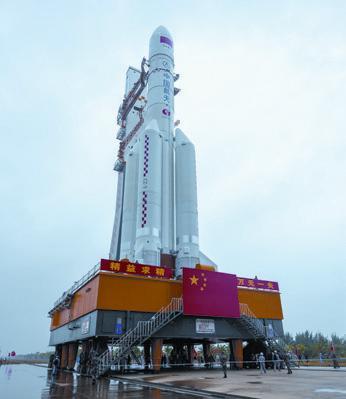The Phoenix Reborn
2020-01-09ByLiQing
By Li Qing

The Change-4 lunar probes landing on the far side of Moon was a good start to Chinas performance in aerospace in early 2019, while the liftoff of the third Long March-5, also known as Long March-5 Y3, saw a remarkable ending. The flawless liftoff overcame the most difficult problem in the countrys carrier rocket history.
Chinas largest carrier rocket
The 57-meter Long March-5 Y3 is the largest carrier rocket in China. It has a 5-meter diameter core stage, 10 engines and four boosters. The rocket weighed nearly 870 tons when it was launched, with a thrust of over 1,000 tons.
It blasted off at 8:45 p.m. on December 27, 2019 from the Wenchang Satellite Launch Center in Hainan Province in south China.
After a huge flame and white flashlight, it soared into the sky carrying the Shijian-20, the heaviest domestic communications satellite with the most advanced technologies. The satellite was sent into the geosynchronous orbit 3,600 km above Earth, marking the success of the fl ight after 2,220 seconds.
At that moment, Wang Weibin, deputy chief designer of the project, finally felt relieved and smiled. He sat in the same seat where 908 days ago, he had seen the failure of the second Long March-5, whose engines were designed by his team.
The rocket has completely independent intellectual property rights. In addition to boosting confidence, it also laid the foundation for Chinas long-term space dream. With the launch, China made 32 successful rocket launches in 2019, ranking fi rst in the world.
Reborn from failure
It took 10 years to carry out the maiden fl ight.
The concept of the Long March-5 came from Chinese rocket scientists in 1986. After 20 years of technological preparations, the rockets research and development (R&D) program was approved and started in 2006 at the China Academy of Launch Vehicle Technology (CALT), a Beijing-based subsidiary of the state-owned space conglomerate China Aerospace Science and Technology Corp. Generally, the proportion of new technology is below 30 percent in the R&D of a new launch vehicle. But with the Long March-5, it reached 95 percent. As a result, its R&D workload was four to five times that of other rockets without extending the development cycle.
To complete the tough task, a team of 10,000 engineers, whose average age is under 35, participated in the project. Besides, new digital technologies were applied to shorten time and decrease costs of R&D.
